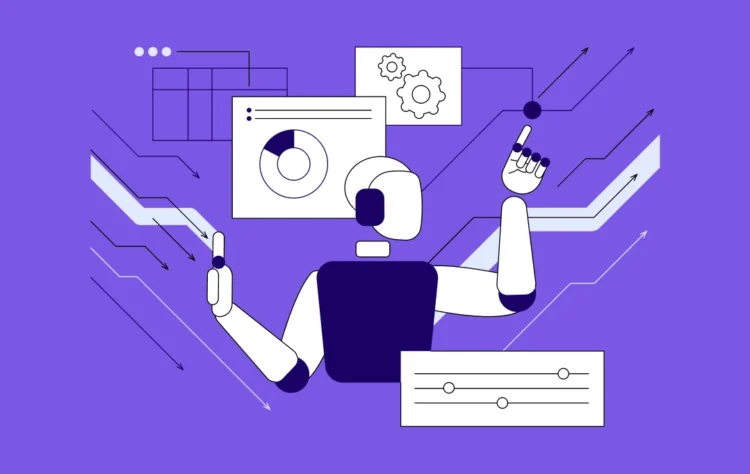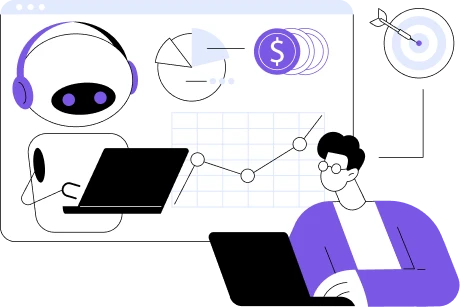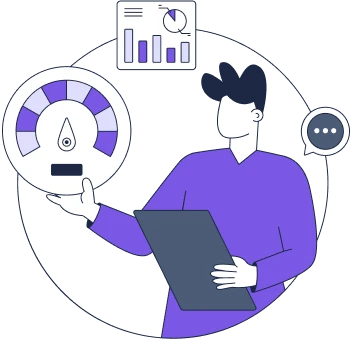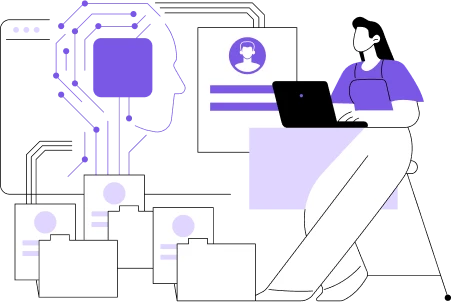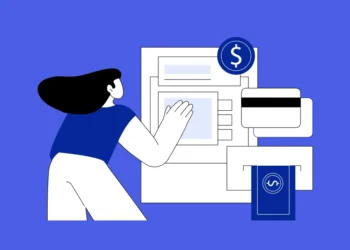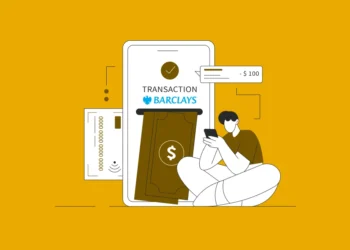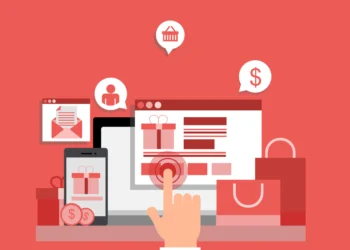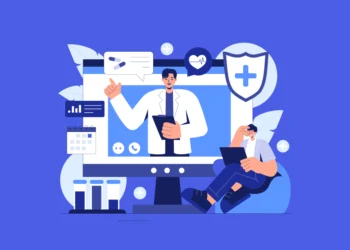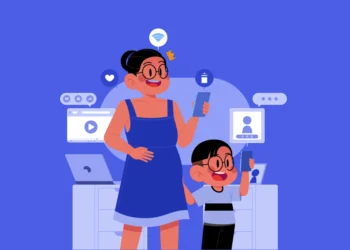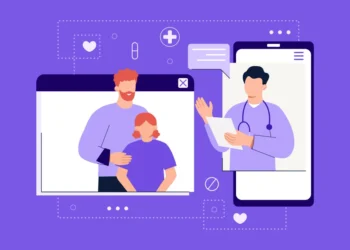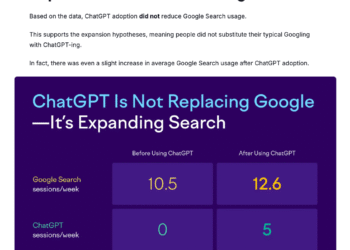Key takeaways:
- Traditional sales forecasting can be off, slow, and hard to adjust when things change.
- AI uses multiple data sources and updates forecasts in real time.
- Retail, manufacturing, and fintech companies see cost savings and smarter decisions with AI.
- Scalable and customizable AI solutions ensure forecasts grow with your business needs.
Sales forecasting is one of those tasks that can really trip up a business. If your team is still buried in spreadsheets or using old systems, you’ve likely seen forecasts go off track or missed opportunities pop up unexpectedly.
AI for sales forecasting changes the game. It doesn’t just look at past numbers. It factors in customer behavior, market trends, and historical sales to give you predictions you can trust.
The best part is that AI keeps learning over time. It picks up on new patterns, changes in customer habits, and shifts in the market, so your forecasts stay on point. And as soon as fresh data comes in, it adjusts the predictions, allowing your team to stay ahead of any sudden changes in demand or trends.
In this blog, we’ll explore how AI is helping companies across different industries forecast smarter. You’ll see how it improves accuracy, cuts waste, and keeps operations flexible. If manual forecasting is still your main tool, it’s worth taking a fresh look.
Want to improve sales forecasting accuracy by up to 50%? Discover how custom AI forecasting solutions can help make your forecasts more reliable.
The Limitations of Traditional Sales Forecasting
Traditional sales forecasting methods can be tricky. Many teams still depend on spreadsheets, look at last year’s numbers, and go with gut instincts to guess what will happen next. It works sometimes, but often the results aren’t very reliable.
Let’s take a closer look at why sticking to these traditional sales forecasting methods can cause problems:
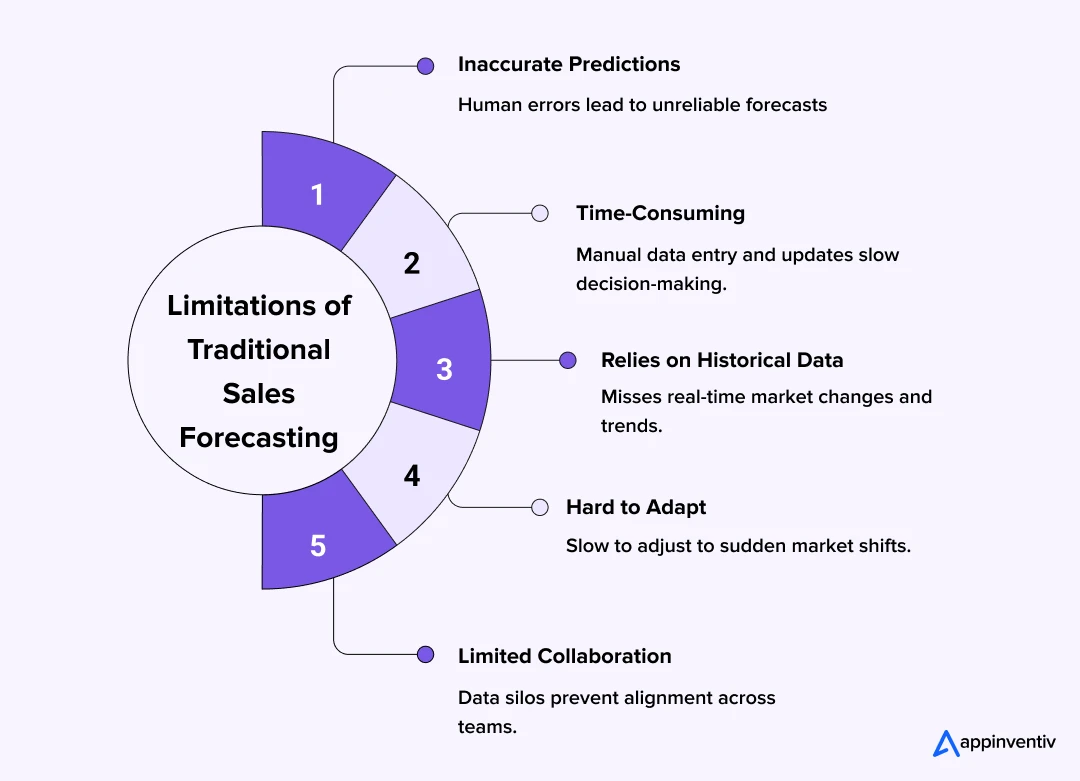
Inaccurate Predictions
Doing everything by hand with spreadsheets can be a real pain. You type in a number wrong, or maybe you miss a pattern. Sometimes you just misread the data. And boom—the whole forecast is off. You end up with too much stock in one spot, not enough staff scheduled, or both. It’s the kind of thing that creeps up on you, causes problems, and nobody even notices at first.
Time-Consuming Processes
Getting all the data together, cleaning it, and making forecasts by hand is exhausting. You enter the same numbers over and over, check everything again, update it constantly. It eats up hours. Sometimes days. By the time you’re done, there’s barely any time left to actually use the forecast. Decisions get slowed down, opportunities slip by.
Limited to Historical Data
Old-school forecasting mostly looks backward. It’s about what happened before. It doesn’t always catch sudden changes in customer behavior, new market trends, or other surprises. That means forecasts can feel outdated before you even look at them.
Difficulty in Adapting to Change
Things change fast in business. A sudden spike in demand or a competitor launching a product throws manual forecasts off. Adjusting them takes forever. Overstocks happen. Stockouts happen. Sales opportunities get missed.
Limited Collaboration
When teams are all working separately, it gets messy. Sales has one set of numbers, marketing another, operations a third. Trying to align everyone? Hard. It slows decision-making and makes planning a headache.
Looking at all this, it’s easy to see why old-school sales forecasting methods struggle. AI for sales forecasting fixes a lot of these problems. It gives teams timely, reliable predictions that you can actually act on.
How AI Transforms Sales Forecasting?
AI is here to stay; that much is clear. It is revolutionizing sales forecasting. According to Gartner, 60% of sales tasks will be handled by AI by 2028, highlighting the critical role AI-powered sales forecasting models are playing in shaping modern sales strategies.
The truth is, markets shift too fast now. Customers change their minds, new players jump in, and the data never stops coming.
That’s why modern sales forecasting with AI has become such a big deal. It isn’t just improving forecasts; it’s completely changing how businesses think about them.
Here is how AI for sales forecasting can help:
- AI collects data from everywhere, ensuring your predictions are always current with what’s going on now.
- When anything changes, AI makes the forecast update automatically so you’re not surprised.
- AI notices the details people naturally do not see, so you get to be one step ahead.
- The mundane tasks are handled by the AI, freeing up the bulk of the work for your team.
- As you grow, AI adapts, keeping your projections sharp regardless of how large you become.
- With the power of AI, your sales forecasts stay current and on schedule so you can make more confident decisions without doubt.
After looking at how AI-powered sales forecasting works, it’s clear that it’s changing the game for businesses. Companies can now predict demand better and adjust their plans faster. Next, we’ll see how different industries are actually using AI in their sales forecasting and what kind of results they’re getting.
Benefits of AI-Driven Sales Forecasting with Cross-Industry Use Cases
Modern Intelligent sales forecasting with AI has changed how businesses plan and react to market shifts. Teams no longer have to rely only on last year’s numbers or guess what might happen next.
With machine learning analyzing data, decisions come faster and feel a lot more reliable because the numbers finally have context behind them.
The shift is happening in every corner of business, from retail and manufacturing to food, beverages, and SaaS. Wherever there is data, AI sales forecasting algorithms are learning from it. The results are clearer forecasts, tighter budgets, and quicker responses when demand changes.
Here is how it is playing out in real companies, along with some Use cases of AI in sales forecasting:
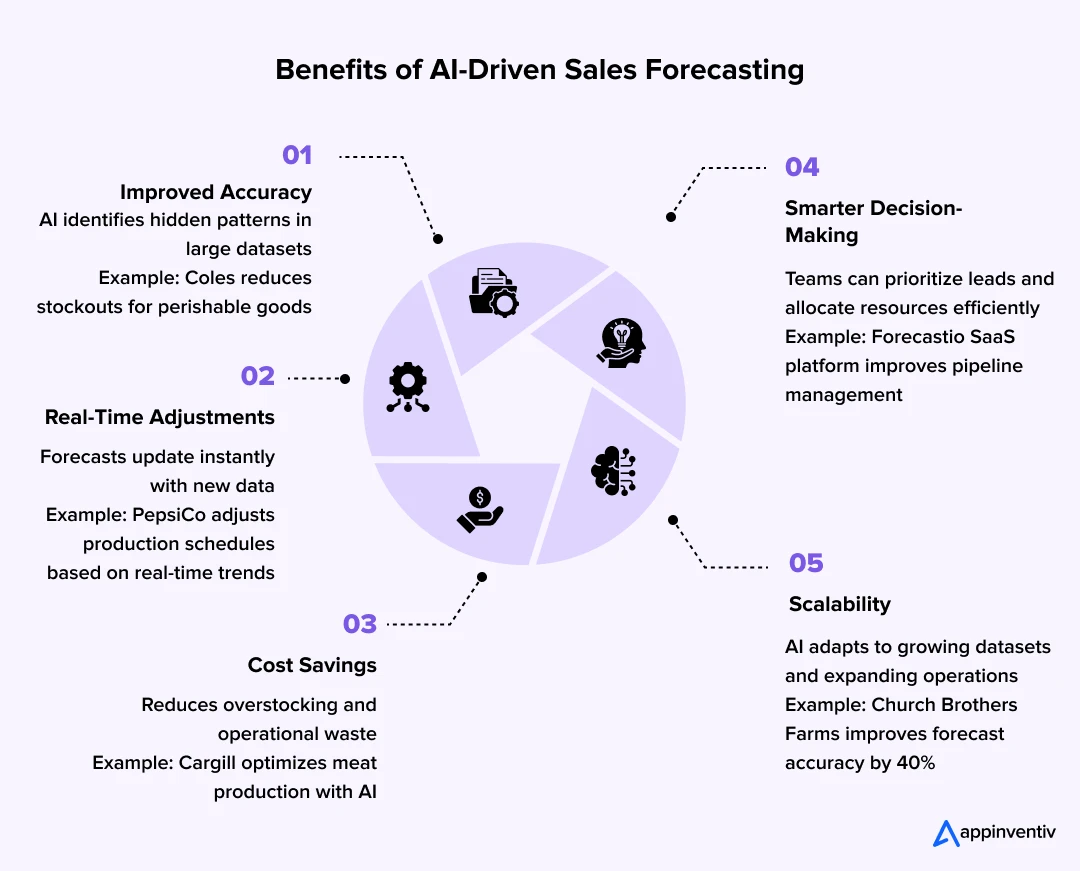
1. Better Accuracy
One of the key benefits of AI in sales forecasting is its ability to catch things the human eye often misses, such as small patterns, new buying habits, and early signs of change. Those details make forecasts sharper and planning smoother.
Example:
At Coles in Australia, AI helps predict how much beer, wine, and other perishables people will buy. It looks at sales history, local events, and even weather forecasts. With that mix, stores can stock the right amount without overdoing it. Customers find what they want, and the store wastes less. It is a subtle change that pays off every single day.
2. Lower Costs
Forecasting is not only about prediction; it is also about saving real money. When companies know what is coming, they can plan staffing, production, and inventory with precision.
Example:
Cargill, one of the world’s biggest food producers, uses AI sales forecasting solutions to sync meat production with what stores are actually ordering. That alignment trims storage costs, prevents excess, and cuts down on waste. The savings add up quickly.
3. Real-Time Flexibility
Among the major benefits of AI in sales forecasting is its ability to work continuously. AI does not stop working after the first forecast. It keeps scanning live data and updating numbers as soon as something changes. Businesses can adjust before problems even appear.
Example:
PepsiCo uses AI to track sales of products like Quaker Oats. If demand rises unexpectedly, the system updates the forecast right away and production follows. The result is fewer shortages, fewer last-minute fixes, and smoother operations overall.
4. Smarter Everyday Decisions
AI adds a layer of insight that goes beyond spreadsheets. It helps teams understand why something is happening and where to focus next.
Example:
Forecastio, a SaaS platform, uses AI to guide sales teams toward high-value leads. With clearer data, they can set priorities, manage pipelines better, and avoid unnecessary guesswork. Less time debating numbers, more time making moves that matter.
5. Built to Scale
The more a company grows, the harder forecasting becomes. More data, more markets, and more variables to manage. AI sales forecasting solutions can handle that complexity without missing a beat.
Example:
Church Brothers Farms, which manages hundreds of produce types, relies on AI to forecast demand and plan distribution. The company boosted short-term accuracy by around 40 percent and reduced excess inventory. It proves that AI keeps up even as operations expand.
These examples show why Machine learning for sales forecasting is quickly becoming standard practice. It is not only about data but about clarity. Businesses that use it make faster decisions, spend less, and react before problems escalate.
Now that we’ve seen what’s possible with AI-powered sales forecasting, here’s how to make it practical for your own business.
How Can You Start Implementing AI in Sales Forecasting?
It is a great move to bring AI in sales forecasting, but don’t rush it. This isn’t about throwing another piece of software into the mix. What you’re really doing is changing the entire way your team predicts what’s coming and how they respond. Companies that get this right? They work smarter, decide faster, and consistently beat their competition.
Let us walk you through what’s worked for others while implementing AI in sales forecasting.
1. Assess Your Current Setup
First things first, figure out what you’re working with now. How does your team forecast today? Where’s the data coming from? What’s slowing everything down? You need to identify the parts where someone’s spending hours entering data manually or just guessing based on gut feeling. Those areas? That’s where AI will save you the most time and give you the best returns.
2. Pick Tools That Fit Your Business
I can’t stress this enough: there’s no one-size-fits-all AI solution. What works for one company might be completely wrong for yours. Find something that matches what you’re actually trying to achieve and plays nice with the technology you already have. Your platform should integrate smoothly, with no complicated workarounds, and provide insights your team can understand and use immediately. Pay attention to flexibility and transparency. You want to know why the AI is telling you what it’s telling you.
3. Prepare and Organize Your Data
Let’s be real here. Garbage in, garbage out. Your AI will only perform as well as the data you feed it. Spend real time cleaning everything up. Sales data, customer records, and market research all need organizing. Check for consistency, fill in missing pieces, and update outdated information. Better data quality means better forecasts, period. Consider this your foundation. Skip it, and everything built on top will be shaky.
4. Train and Test the Models
Time to put machine learning to work. Build your predictive analytics for sales forecasting models and test them against past data. How close did they get? Keep tweaking as fresh data comes through. This stage is where the magic happens. AI starts picking up on sales patterns, understanding seasonal fluctuations, and reading market signals. Your team gets insights faster, and they’re backed by solid evidence instead of hunches.
5. Integrate and Keep an Eye on Results
Deploy this across your entire operation. Sales, marketing, operations, everyone. Make sure all teams are referencing the same forecasts. Then monitor how it’s performing. Review the outputs regularly. Something looks off? Adjust it. Keeping a close watch ensures your models stay accurate and that these insights translate into real improvements, not just fancy dashboards nobody uses.
6. Expand When You’re Ready
Your business grows, your forecasting needs grow. Simple as that. AI handles this expansion well. More data points, additional product lines, new markets, whatever. It scales without losing accuracy. A good system adapts as your operations get more complex and keeps delivering reliable forecasts no matter how big you get.
Turn Insights into Action
Harness AI to predict demand, prioritize leads, and make data-driven sales decisions with confidence. Appinventiv offers custom AI development services tailored to your business.
After you’ve got everything implemented, connect your forecasting engine to your CRM and whatever other platforms you’re running. This keeps data flowing constantly between sales activities and customer behaviors.
Why Should You Start AI Forecasting Integration with CRM Systems?
Integrating AI for sales forecasting with your CRM system isn’t some futuristic concept anymore. It’s becoming standard practice for enterprises that want better sales forecasting.
When you combine CRM data with lead scoring and conversion prediction for sales forecasting, your sales teams can focus efforts where they’ll make the most impact, rather than spreading resources thin.
Once you’ve got AI forecasting integration with CRM working, your sales teams can do some pretty powerful stuff:
- Figure out which leads actually matter by spotting the high-potential prospects
- Predict how customers will behave based on their past interactions and how they’ve been engaging
- Get way more accurate forecasts by pulling together CRM data with everything else you’re tracking operationally
Together, CRM data, lead scoring, and conversion prediction for sales forecasting allow enterprises to better understand their sales pipeline health and conversion likelihood at every stage.
This kind of integration helps businesses make smarter calls, cut down on mistakes, and react faster when the market shifts. Companies that are already using AI forecasting integration with CRM? They’re reporting noticeably better forecast accuracy, and they’re allocating resources more effectively.
Also Read: How Chatbot CRM Integration Transforms Customer Experience
Now, as AI gets woven deeper into forecasting and decision making, we’re taking on new responsibilities here. Sure, accuracy and automation matter a lot. But so do fairness, transparency, and accountability. Maybe even more so.
Learn About the Ethical Considerations in AI Sales Forecasting
Look, as AI becomes the backbone of sales forecasting, you can’t just focus on getting accurate numbers fast. That’s not enough anymore. Your forecasts need to be fair, easy to understand, and trustworthy.
Here’s the problem: without someone watching closely, AI models start developing biases. They misread data. They make calls that hurt specific customer groups or create chaos internally.
So what should you actually be paying attention to? Let us break it down.
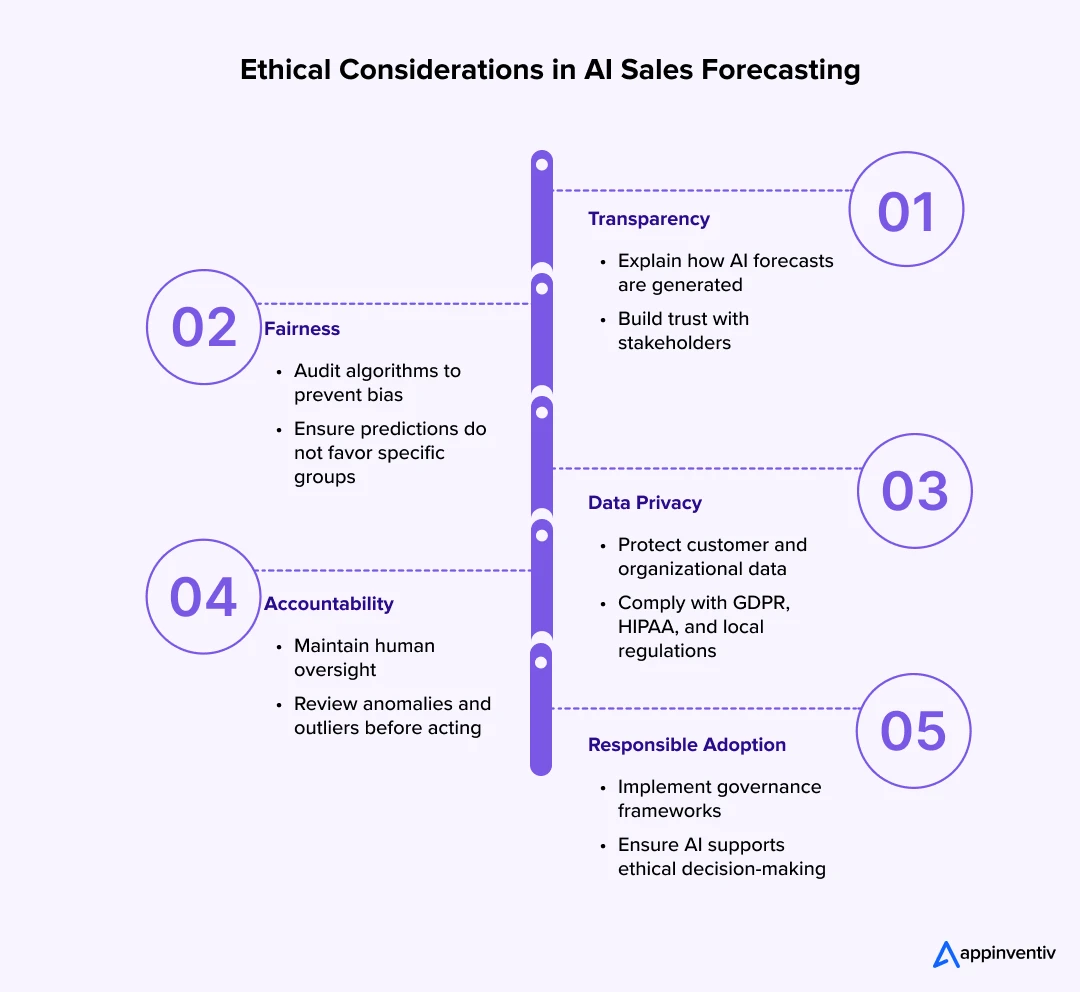
1. Transparency in Predictions
Your stakeholders need to see how you got to these numbers. It can’t be a black box. Say your AI tells you a product is going to see huge demand. Great, but why? Show them what’s driving that.
Maybe it’s past sales data, seasonal buying patterns, or how engaged customers have been lately. When people can see the logic, they trust it more. Your teams can also double-check whether it makes sense or if something’s off.
2. Fairness and Bias Mitigation
Here’s something that happens a lot: AI starts favoring certain regions, certain demographics, specific product lines. Why? Because the historical data it learned from was already skewed that way. You need regular audits on your algorithms to catch this stuff.
Think about a retail chain trying to forecast demand everywhere. If the AI keeps predicting higher demand for city stores and basically ignoring rural areas, you’ve got a bias problem. Fix it before it costs you.
3. Data Privacy and Compliance
Forecasting pulls from everywhere. Your CRM, transaction records, outside datasets, you name it. Which means you absolutely have to follow GDPR, HIPAA, and whatever regulations apply where you operate.
This isn’t just about avoiding legal trouble, though that’s obviously important. Bad data management screws up your AI predictions, too. So you’re hurting accuracy and risking lawsuits at the same time.
4. Accountability and Human Oversight
AI is helpful, no question. But it’s still just a tool. Don’t let it make final decisions on its own. Keep humans in the loop. Have your analysts look at strange spikes, odd patterns, and anything unexpected before anyone takes action based on it.
This catches mistakes early and keeps everything aligned with your actual strategy instead of what an algorithm thinks should happen.
Actionable Tip
A lot of enterprises are creating AI ethics committees now. Or they’re appointing specific people as data stewards. Their whole job is watching forecast quality, making sure you’re following regulations, checking that AI suggestions match what your business actually values and what customers expect from you. Worth considering if you haven’t already.
Getting ethical practices right in AI forecasting isn’t just about good morals. It’s good business. When your systems are transparent and people trust them, you can scale confidently. New regions, new products, new markets, whatever comes next. You’ve built something that grows responsibly instead of creating problems as it expands.
Scalability of AI Solutions
One of the best things about AI in sales forecasting? It grows right alongside your business. Traditional forecasting methods hit a wall pretty quickly. AI doesn’t. It handles bigger datasets, more products, and new markets, and it keeps the accuracy consistent. That scalability means your forecasts stay useful even when operations get way more complicated.
Let us show you what scalable AI sales forecasting actually looks like in practice:
Data Volume Management
AI sales forecasting chews through massive amounts of information without breaking a sweat. We’re talking hundreds of thousands of transactions, customer interactions, and historical records, all at once. Large retailers are doing this right now. They’re pulling data from dozens or hundreds of stores and generating accurate, real-time demand forecasts. And the system doesn’t slow down doing it.
Expanding Product Lines
Your company adds new SKUs or launches new services. No problem. AI models just fold those additional data points right into the forecasts. So even as what you’re offering keeps expanding, the predictions stay sharp. E-commerce platforms launching seasonal stuff or completely new product categories? They’re using AI to adjust forecasts on the fly.
Multi-Region Forecasting
If you’re operating in multiple regions, AI accounts for all those local differences. Think about a food distribution company. They need to predict demand region by region, factoring in historical sales, local holidays, regional buying trends, and all the unique stuff. Get this right, and you avoid overstocking where demand is low and running out of stock where demand is high.
Flexible Infrastructure
Cloud-based AI sales forecasting systems scale up computational power whenever you need it. Your datasets get bigger, forecasting gets more complex, and you just expand the infrastructure. No massive investment in servers, you have to maintain yourself. This flexibility matters a lot if you deal with seasonal spikes or you’re growing fast and can’t predict exactly when you’ll need more capacity.
Cross-Functional Application
Scalable AI doesn’t have to live only with your sales team. Marketing can use it. Operations can use it. Supply chain teams, too. They’re all leveraging the same forecasting models to line up campaigns, manage inventory better, and coordinate logistics. Suddenly, everyone’s working from the same playbook instead of making conflicting plans.
Here’s something people forget, though. Technology alone doesn’t cut it. You need people who actually know how to use it well. Scaling AI successfully means making sure your teams understand how these forecasts get made and what to do with them.
Employee training and getting people to actually adopt this stuff? That’s what bridges the gap between having insights and actually executing on them. It turns AI from just another tool into something the whole organization can use effectively.
Employee Training and Adoption
You can have the most sophisticated AI system in the world, but if your teams don’t know how to use it? It’s basically useless. Training matters because it’s what lets your sales, marketing, and operations people actually interpret those AI forecasts and do something with them. That’s where you get your ROI.
So how do you get people on board and use this effectively?
Understanding AI Insights
Your teams need to know how these forecasts are being made. What data is going in? What’s the algorithm doing with it? Sales managers, for instance, should understand how seasonal trends affect predictions, or how promotions change things, or why customer behavior matters.
Teams trained in lead scoring and conversion prediction for sales forecasting can interpret why certain leads are prioritized and how predictive models influence deal outcomes. This builds trust in the AI’s recommendations. When they get the logic, they make decisions with confidence instead of second-guessing everything.
Integrating AI into Workflows
Forecasts can’t just sit in a dashboard somewhere. They need to be part of what people do every day. Sales reps should be using AI to figure out which leads to go after first. Inventory managers should be adjusting stock based on what demand is predicted to look like. Marketing teams should be timing campaigns around projected trends. Make the insights actionable, not just interesting information people glance at once.
Change Management
Here’s the big one. You need to build a culture where AI is seen as helpful, not threatening. It’s a support tool, not something that’s replacing people. Get your teams comfortable trusting AI insights while still keeping human judgment in the mix. Resistance drops when people see it that way. Highlight the folks who adopt it early. Share their wins. Show everyone else what’s possible.
Continuous Learning
AI isn’t static. It evolves. Your models get updated, new features roll out, algorithms get refined. So training can’t be a one-time thing either. You need ongoing sessions to keep everyone up to speed. Regular workshops work well. The goal is making sure people can read the data correctly and act on forecasts without hesitation.
Feedback Loops
This part gets overlooked a lot, but it’s crucial. Ask your teams what they’re seeing. Real-world feedback from the people actually using these forecasts? Feed that back into the system. It refines predictions and improves accuracy over time. You’re creating an environment where AI and human expertise are working together instead of operating in separate silos.
Once your employees feel confident with these AI tools, that’s when you can start thinking bigger about what’s next in forecasting. The future’s going to bring smarter predictive models, deeper connections with other technologies you’re using, and more personalized insights that let companies see demand shifts coming before they actually happen.
Which Future Trends in AI Sales Forecasting You Should Look Out For?
Sales forecasting is changing fast. Really fast. AI isn’t just about predicting how much you’ll sell anymore. It’s reshaping how businesses understand demand, connect with customers, and react to what’s happening in the market right now.
As more organizations weave AI into their sales operations, we’re seeing some clear trends emerge that are defining where this technology goes next.
Let us walk you through what’s happening in the predictive analytics for sales forecasting industry right now:
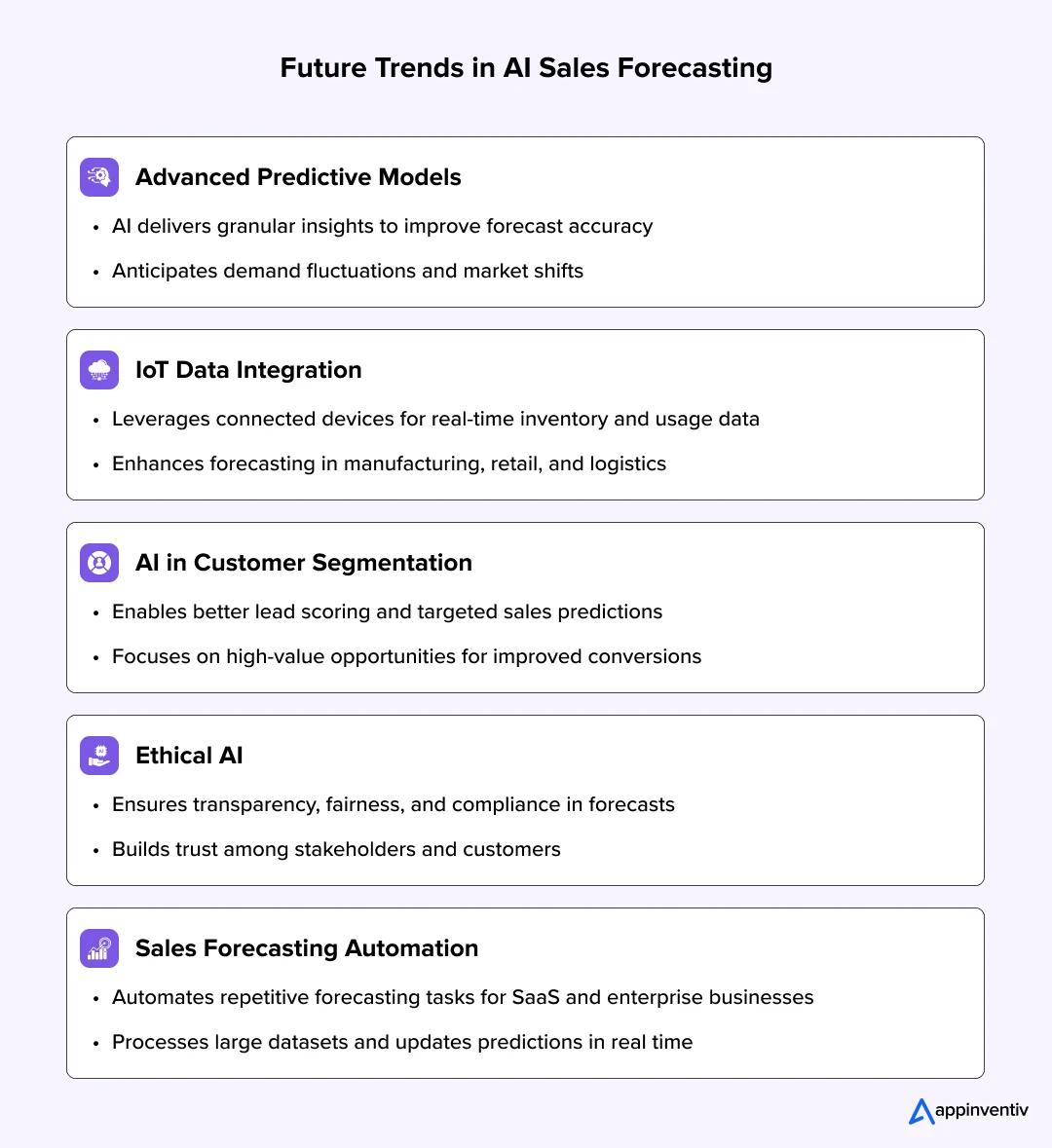
1. Advanced Predictive Models
AI-based sales forecasting for enterprises is evolving fast, with models becoming far more sophisticated than ever before. They’re giving companies much more detailed insights into how customers behave and where sales trends are heading.
This is letting businesses adopt modern forecasting approaches that are just more precise and reliable than what we had before. These advanced models can also spot demand fluctuations coming, which means companies can get ahead of things instead of scrambling to catch up.
2. Integration with IoT
IoT devices are everywhere now, right? All that IoT data from connected devices can flow directly into AI-based sales forecasting for enterprises, creating a continuous loop of real-time intelligence.
For industries like manufacturing and retail, this is huge because you’re getting real-time information about inventory levels, how products are being used, and what’s happening operationally. When you combine this with AI forecasting that’s already integrated into your CRM, you can match sales strategies to actual demand signals instead of guessing.
3. AI in Customer Segmentation
More businesses are using AI to break down their customer base by behavior, what people prefer, buying patterns, all of it. This helps with lead scoring and predicting which prospects will actually convert. Sales teams can zero in on the high-value opportunities instead of wasting time on long shots. Smarter segmentation basically means you’re putting the right offer in front of the right customer at exactly the right moment.
4. Ethical AI
As AI gets deeper into forecasting, the ethical side matters more. Transparency, fairness, and whether you can trust what the AI is telling you. Using custom AI solutions responsibly means making sure predictions aren’t biased and that decision-makers can actually rely on them. This builds confidence instead of skepticism.
5. Sales Forecasting Automation with AI
Automation’s going to keep being a massive trend. It cuts down the time and effort you need to generate accurate forecasts by a lot. Sales forecasting automation with AI systems processes huge datasets, updates forecasts as things change, and spots trends that humans would miss when doing this manually.
Software as a service companies are seeing big benefits here. AI sales forecasting for SaaS helps them predict subscription renewals, figure out which customers might churn, and project revenue growth, all with way less manual work.
AI is genuinely transforming how forecasting works. Higher accuracy, insights in real time, solutions that scale as you grow. Businesses adopting AI-based forecasting for enterprise operations can make smarter decisions, optimize inventory better, and respond faster when markets shift. That’s a real competitive edge. And we’re seeing measurable improvements across industries. Better sales performance, smarter resource allocation, and the results are there.
Also Read: AI in Marketing – Benefits, Use Cases, and Beyond
How Appinventiv Can Help?
At Appinventiv, we provide AI Development Services that are tailored to your business needs, offering customized AI sales forecasting solutions that integrate seamlessly into your operations. Our expertise spans across 35+ industries, helping enterprises stay ahead with real-time insights and continuous support.
Here is why you should choose Appinventiv:
- 35+ Industries Mastered
- 1600+ Tech Evangelists
- 3000+ Solutions Designed and Delivered
- 500+ Legacy Processes Transformed
- 5+ Strategic Federal Partnerships
With our AI Consulting Services, we ensure your AI solutions evolve alongside your business, giving you the tools to make smarter, data-driven decisions.
Take the next step toward smarter, more reliable sales forecasting today and invest in AI sales prediction tools.
FAQs
Q. How soon can it take to install AI-powered forecasting for sales?
A. Timeframe is highly dependent upon where you’re coming from and how ready your data is. Simple implementations? You’re in the 6 to 12-week range from the beginning to the end. But when you’re dealing with something a little bit more complicated like multiple regions, hundreds of diverse product lines, or data that’s stored in systems that don’t converse with each other, it’s going to take longer.
The real bottleneck the majority of the time isn’t the AI itself. It’s getting your current data so that it’s all dialed in and correct so that the AI has something to learn from it and produce predictions that you actually trust and take advantage of.
Q. Is it possible to tailor the AI predictive model for various industries or products?
A. Definitely. AI models may be customized to suit particular industries, business models, or lines of business. Each industry incurs differently through unique patterns of business, season highs and lows, and marketplace conditions.
How retail companies are managed is utterly distinct from B2B manufacturing organizations, and the AI model must consider these discrepancies. Tailoring guarantees predictions are aligned with your true business conditions rather than basing the model on broad assumptions that could or may not align with your current experience.
Q. How much more accurate are AI predictions than the classical methods?
A. AI can increase accuracy by a lot when pitted against human forecasting techniques. How does it vary? AI keeps learning when new data streams in, picks up patterns that humans most consistently miss, and adjusts when customer behavior or market dynamics change.
Standard techniques generally rely on fixed formulas and previous averages, which take a long time to change when the market turns. AI becomes smarter the longer it operates, so the predictions become more accurate the longer you wait and the system accumulates more experience.
Q. What are the sources for AI’s data, and how much data needs to exist to get started?
A. AI pulls data from a wide range of sources like CRMs, ERP modules, marketing modules, customer communications, and even external market conditions. The silver lining here is that you needn’t have voluminous datasets to get started.
Old-sale histories and a small customer base are generally enough for getting the system up and running. The longer the AI has data to work with, the better the predictions get and the closer to accuracy. Think of it like a learning process that gets better with experience and exposure to the real world in the form of data from your business.
Q. How does bias or fairness address AI sales forecasting?
A. AI models are often-reviewed to spot and reduce bias that seeps into predictions. This makes a real difference because biased data creates biased predictions that aren’t truly reflecting what’s happening in your business. This is where human intervention comes in. Experts review the model’s predictions so that it’s fair, understandable, and faithful to the true needs of your business.
This is a long way from letting the AI run itself without human supervision. There’s a feedback cycle where the work’s reviewed by human beings and fixed where it doesn’t seem quite right or doesn’t make sense to the real world.
Q. Can you apply AI sales forecasting to software organizations?
A. Yes, AI sales forecasting for SaaS works particularly well. It analyzes subscription data, tracks usage patterns, and monitors market trends to help predict renewals, churn rates, and revenue growth more accurately.
SaaS companies have their own unique metrics like MRR, ARR, and customer lifetime value that AI can factor into forecasts. This helps SaaS businesses plan resources more effectively, identify at-risk customers before they cancel, and find upsell opportunities they might have otherwise missed completely.

